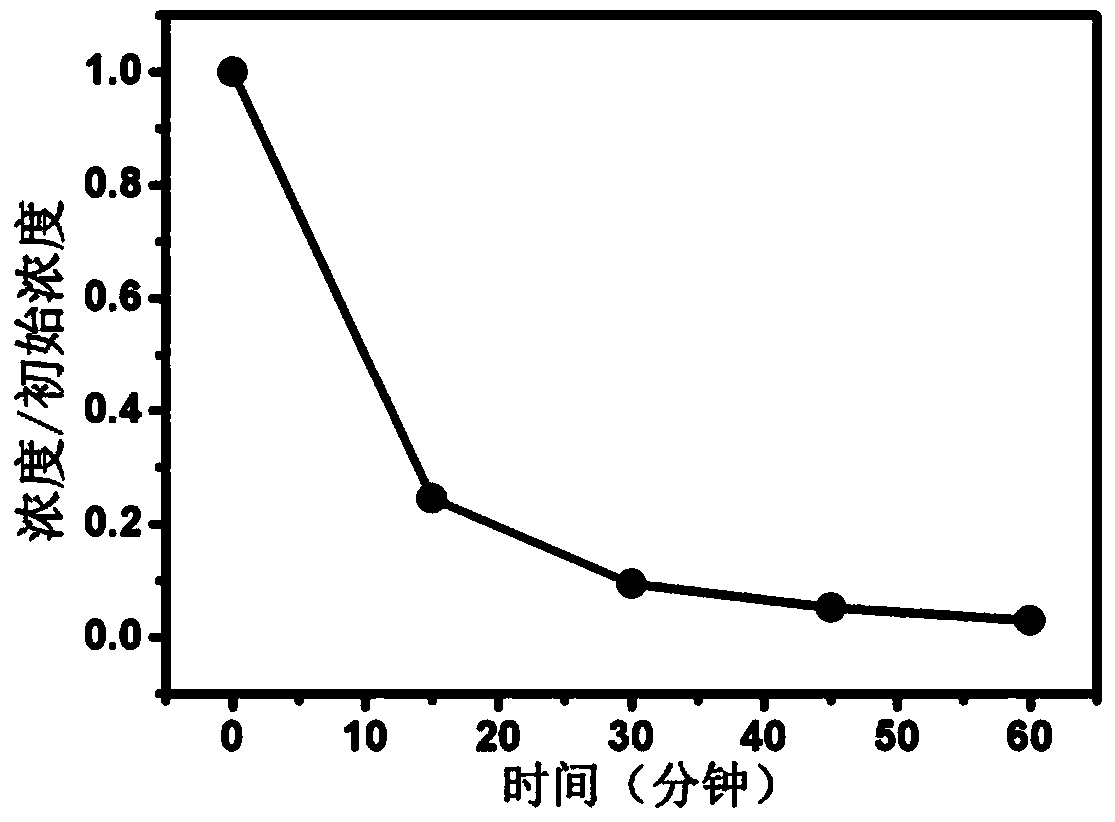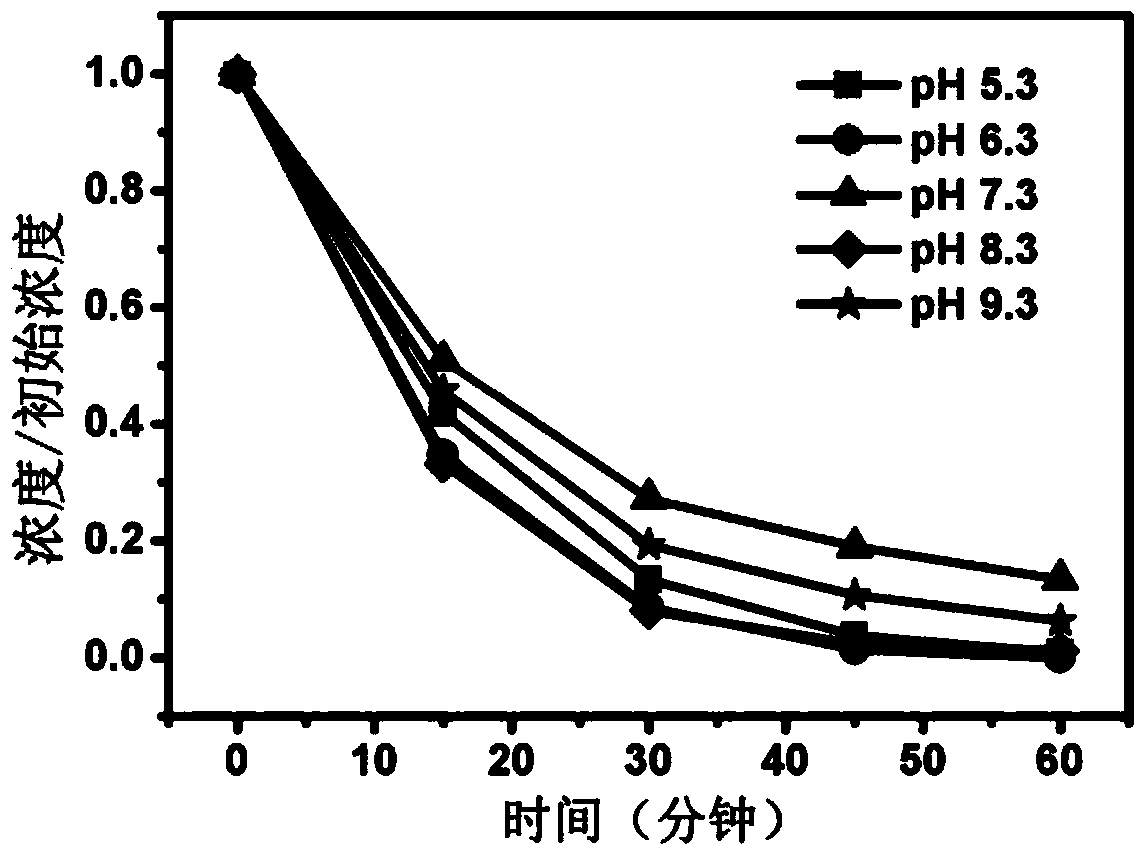Molecular oxygen activation-coupled water treatment method employing high-efficiency neutral electro-fenton oxidation
A technology of oxidizing water and treatment methods, applied in water/sewage treatment, chemical instruments and methods, water/sludge/sewage treatment, etc., can solve problems such as increasing wastewater treatment costs, unfavorable wastewater discharge, and corrosion of equipment. To achieve the effect of simplifying the subsequent treatment process, avoiding iron sludge, and not easy to decompose
- Summary
- Abstract
- Description
- Claims
- Application Information
AI Technical Summary
Problems solved by technology
Method used
Image
Examples
Embodiment 1
[0033] Example 1 Treatment of wastewater containing dye rhodamine B
[0034] Aiming at the electro-Fenton remediation of dye-contaminated water sources, this example uses a self-prepared Rhodamine B aqueous solution as the experimental subject to perform a high-efficiency neutral electro-Fenton treatment experiment with coupled molecular oxygen activation.
[0035] Rhodamine B aqueous solution with a concentration of 10 mg / L was used as simulated wastewater, and the pH of the rhodamine B aqueous solution was 6.6 (no need to add acid and alkali to adjust the pH). Take 25 mL of simulated wastewater, and add sodium tetrapolyphosphate to make the concentration 0.3 mmol / L. The iron wire is used as the anode, the activated carbon fiber is the cathode, the constant current is 0.6mA, the anode current density is 6A / m2, air is blown into the cathode through the aeration device, the air flow rate is 40mL / min, and the simulated wastewater is electro-Fenton oxidation deal with. Such as figur...
Embodiment 2
[0037] Example 2 Treatment of sewage containing pesticide atrazine
[0038] Aiming at the electric Fenton remediation of pesticide-contaminated water sources, this example uses a self-prepared atrazine aqueous solution as the experimental object to carry out an efficient neutral electric Fenton treatment experiment with coupled molecular oxygen activation.
[0039] Taking the atrazine aqueous solution with a concentration of 15 mg / L as the simulated wastewater, the pH of the atrazine aqueous solution is 6.8 (no need to add acid and alkali to adjust the pH). Take 25 mL of simulated wastewater, and add sodium tripolyphosphate to make the concentration 0.5 mmol / L. The iron wire is used as the anode, the activated carbon fiber is the cathode, the constant current is 0.5mA, the anode current density is 5A / m2, air is blown into the cathode through the aeration device, the air flow rate is 60mL / min, and the simulated wastewater is electro-Fenton oxidation deal with. Such as figure 2 As...
Embodiment 3
[0040] Example 3 Treatment of sewage containing pesticide atrazine under different pH conditions
[0041] In this example, a self-prepared atrazine aqueous solution was used as the experimental object to carry out an efficient neutral electric Fenton treatment experiment with coupled molecular oxygen activation.
[0042] Take the atrazine aqueous solution with a concentration of 15 mg / L as the simulated wastewater, add sodium tetrapolyphosphate to the concentration of 0.5 mmol / L, and adjust the initial pH of the solution to 5.3, 6.3, 7.3, 8.3 with NaOH or HCl solution, respectively , 9.3. Take 25mL of simulated wastewater with different initial pH, use iron wire as anode, activated carbon fiber as cathode, constant current 0.5mA, anode current density of 5A / m2, and blow air into the cathode through an aeration device at a flow rate of 60mL / min, the simulated wastewater is subjected to electric Fenton oxidation treatment. Such as image 3 As shown, after 1 hour of electro-Fenton ...
PUM
| Property | Measurement | Unit |
|---|---|---|
| decolorization rate | aaaaa | aaaaa |
Abstract
Description
Claims
Application Information
 Login to View More
Login to View More - R&D
- Intellectual Property
- Life Sciences
- Materials
- Tech Scout
- Unparalleled Data Quality
- Higher Quality Content
- 60% Fewer Hallucinations
Browse by: Latest US Patents, China's latest patents, Technical Efficacy Thesaurus, Application Domain, Technology Topic, Popular Technical Reports.
© 2025 PatSnap. All rights reserved.Legal|Privacy policy|Modern Slavery Act Transparency Statement|Sitemap|About US| Contact US: help@patsnap.com



